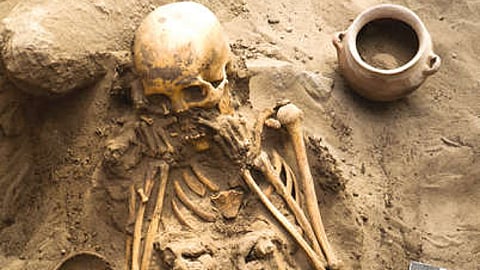

On Sept 22, Carlos Lalangui was digging a trench to make way for a natural gas pipeline on the outskirts of this city when he spotted fragments of a human skull a dozen inches down in the loosened soil. “It was the first time I’d seen something like that,” said Lalangui, a worker with the natural gas company Cálidda. “But I knew it was a possibility.”
He stopped digging and notified his supervisor, who called in archaeologists. In a little more than a week, they had uncovered the remains of 21 people, eight of them children, who lived 600 to 800 years ago, said Cecilia Camargo, an archaeologist with the company. Most had been buried in a classic pre-Columbian style in Peru: their bodies bound in a sitting fetal position and bundled in layers of textiles, surrounded by ceramic vessels, plates, pots and figurines. One of the adults, thought to be a warrior, was found lain horizontally on reeds with a star-shaped mace of stone; the remains of a 2-year-old were found close by.
The graves, discovered in a residential neighborhood in Carabayllo, a district in northern Lima province, were a reminder of Peru’s seemingly ubiquitous pre-Columbian cultural legacy, which continues to surface long after the Spanish conquest decimated the Indigenous population.
In Lima, huacas — pyramid-like mounds of adobe brick that were once used as sacred and administrative centers — are the most visible reminder of the city’s ancient inhabitants. Dozens of ruins of huacas remain nestled among skyscrapers, middle-class neighbourhoods and shanty-towns. In recent years, ancient tombs and ceramics have been found during the expansion of the city’s airport and during the construction of a courthouse and a hydroelectric dam in towns nearby. Earlier this year, a resident of Lima called culture authorities to report funeral bundles he found while doing construction work on his house, said Yuri Castro, the culture ministry’s director of archaeological heritage.
Peru’s culture ministry has registered some 26,000 archaeological sites across the country. But budget constraints mean that only a fraction can be properly protected, Castro said. More than 1,100 sites are in Lima, a sprawling metropolis of 10 million people that has been occupied for more than 3,000 years. “Those are only the sites that remain,” Castro said. “With the city’s expansion they’ve gradually disappeared.” Cálidda has made more than 1,500 archaeological findings in the nine years it has been laying natural gas pipelines across the city’s metropolitan area, said Camargo, and it employs a team of 30 archaeologists. “In Lima, 3,000 years of history are literally just beneath our feet,” she said. “We’ve made findings in nearly every district.” Before the Incan empire arose in the Andes in the 15th century, complex societies learned to thrive along Peru’s desert coast by irrigating fertile valleys and harvesting abundant fish stocks from the Pacific. Archaeologists hope that the new discovery can help shed light on those early cultures.
Today the coastal region is home to most of Peru’s population, and countless sites have already been lost to looting and development. “It’s a victory every time archaeologists can recover something responsibly and put it into the record,” said Daniel Sandweiss, the president of the Society for American Archaeology, who studies how pre-Columbian coastal societies in Peru adapted to climate change caused by El Nino. “Peru has the most fascinating pre-European records of any place in the Americas.”
Visit news.dtnext.in to explore our interactive epaper!
Download the DT Next app for more exciting features!
Click here for iOS
Click here for Android